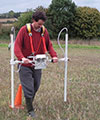May
Contaminated green waste has ‘catastrophic’ implications for historic environment

Archaeologists are calling for better regulation of the control and use of green waste in order to protect the historic environment.
Research carried out at Newcastle University has highlighted that the level of metallic contaminants within green waste is having a detrimental effect on geophysical surveys – a vital tool used by archaeologists to survey an area of historical interest. This has potentially ‘catastrophic’ implications for understanding the hidden history across large parts of the UK, the researchers say.
Green waste is produced from organic and biodegradable household waste and is part of most local authorities’ environmental strategies in order to meet legally binding targets for reductions in the amount of waste being landfilled. There is a growing market for composted green waste, which is commonly used by farmers as fertiliser on arable land.
However, current regulations permit up to 0.25% of composted material to be formed of non-organic waste. This often includes metal fragments, batteries, plastics, glass and other materials. Although this is a small amount, the research team argues that contaminants will increase over time with successive applications of green waste, creating interference in the magnetic data identified by geophysical surveys.
Dr James Gerrard, from Newcastle University’s School of History, Classics and Archaeology, said: “Contaminated green waste is a significant and growing problem for archaeology.
“In many cases, the results of a geophysical survey are the only evidence that there is something of archaeological interest below the surface. More stringent regulation and robust enforcement are needed to ensure that archaeologists can continue to rely on geophysical surveys when prospecting an area.”
The research team looked at the area around a previously unknown settlement close to a Roman villa near Lufton, Somerset. Just before the first geophysical survey was carried out in 2011, the landowner spread green waste over the fields. As a result, the survey results were of poor quality. The same site was surveyed again in 2013, but there had been little reduction in interference in the intervening period.
The research is published in the journal Archaeological Prospection.
Pictured: Dr James Gerrard carries out a geophysical survey.
published on: 21 May 2015
